
by Stephanie Herzog | Jul 25, 2019
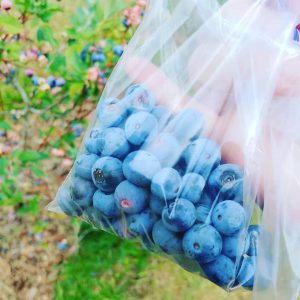
Eating fresh, local produce is a great way to be healthier, save money, and support the local economy. (Photo source: Stephanie Herzog)
Summer Local Eats – Supporting Farmers’ Markets
Summer is a great time of year to eat locally grown fresh produce! There are many options rich in a variety of colors, shapes, sizes, and nutrients. Farmers work hard to provide life-sustaining sustenance for society, and consumers supporting their efforts at the local level has an array of health and economic benefits.
Fresh summer crops in the panhandle abound. Produce that is ready this time of year includes peppers, cucumber, peanuts, okra, squash, corn, and watermelon. Spice up a summer salad with fresh cucumbers or peppers or try tasty yellow meat watermelon for a chill and nutritious summertime snack! Local, fresh produce is a healthy alternative to processed foods or produce found in grocery stores. Produce sold by local farmers is freshly picked and because you know where it comes from, it is both safer to eat and keeps for longer periods of time than grocery store produce, which often has traveled long distances, is seldom inspected, and is kept in storage before finally being put out on the floor for purchase.
Supporting your farmers’ market benefits both you and your community in many ways. Purchasing from local farmers and farmers’ markets is both financially sound for you and is supportive of the community’s economy – the money changes hands locally and creates and maintains jobs. Not only does it benefit the economy, it also fosters a stronger sense of community unity and trusted relationships, which is vital to any successful society and local economy. For example, farmers will sometimes offer a “u-pick” program, depending on the crop, where you go to their farm and pick what produce you want right from the field! You get to keep half, and the farmer keeps half. This is a great cooperative effort that benefits everyone – you get free, fresh produce, and the farmer gets free labor. Who doesn’t love a win-win scenario?
Jackson County farmers’ markets information. Residents in Jackson County have a wonderful farmers’ market in the heart of downtown Marianna, located at Madison Street Park (2881 Madison St.) that goes throughout the summer every Tuesday, Thursday, and Saturday morning from 7am-12pm. After September, the market will continue through the fall, winter, and spring each Saturday at the same time. Tuesday and Thursday have farmer vendors only, while Saturday includes a variety of vendors, such as arts and crafts, plants and flowers, jams, jellies, honey, etc. This market also offers a raffle when you purchase items from vendors! For any questions about the market or how to join as a vendor, visit their Facebook page or contact Tony Mayo, the current farmers’ market manager or Terry Johnson, the public relations manager for the market. His number is 850-592-5114. It’s a good idea to bring cash or checks, but some vendors do accept credit and debit cards.
Want to find a farmers’ market near you or learn more about the benefits and best practices shopping at a farmers’ market?
Come experience the buzz and benefits of the farmers’ market!
Sources:
Local farmers at the Marianna City Farmers’ Market
Wang, Q., Evans, E. A., Pikarsky, M., & Olczyk, T. Consuming local vegetables from our local growers. UF IFAS publication HS1251.

by Heidi Copeland | Jun 20, 2019
Part of cultivating a healthy, sustainable food system is to learning eat seasonally and locally. This means enjoying foods at their seasonal peak. In addition, there is value knowing when produce items are in season as these products are often tastier, healthier, fresher and more economical. Additionally, eating seasonally encourages a varied diet.
According to the Florida Department of Agriculture and Consumer Services (FDACS), Fresh From Florida produce is plentiful! The month of June is especially productive! June claims: Fresh From Florida avocado, cantaloupe, carambola, eggplant, guava, lychee, mango, mushroom, oranges, papaya, passion fruit, peanut, potatoes, sweet corn, tomatoes and watermelon!
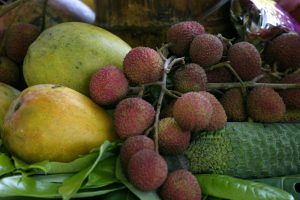
Tropical Fruit Day, 2005. UF/IFAS Photo Source: Thomas Wright.
Most of the listed produce items are pretty conventional. But what about something not so straightforward like the lychee?
The lychee (Litchi chinensis), linked to the Sapindus genus, is native to warm temperate tropical regions of southern China. The lychee is harvested ready to eat. The lychee is covered with a hard, non-edible covering and contains a crisp, juicy, sweet pleasant inner (tasting a bit like a cross between a strawberry and a grape). Lychee are a great source of nutrients, containing, energy (carbohydrates) as well as vitamins, minerals and fiber. Lychee can be consumed fresh off the tree, frozen, canned, pickled, dried or even as ingredients in salads, marinades, sauces or desserts.
Try it! You just might like it! The University Florida UF/IFAS Extension has a great publication if you are interested in growing lychee. https://edis.ifas.ufl.edu/pdffiles/MG/MG05100.pdf The World Wide Web has a plethora of interesting recipes for the lychee as well that you can check out.
Lychee Growing in the Florida Home Landscape https://edis.ifas.ufl.edu/pdffiles/MG/MG05100.pdf
Florida Crops in Season https://www.freshfromflorida.com/Consumer-Resources/Buy-Fresh-From-Florida/Crops-in-Season

by Angela Hinkle | Jul 11, 2018
The pickin’ is plentiful and life is good. Now is the time to take advantage of summer’s bounty. Summer produce is colorful and healthy. It tastes amazing. And right now, it’s everywhere!
Fruits and Veggies in Season
Buying summer produce now means you get fruits and vegetables that taste their best. See Panhandle Produce in Season for what’s in season in the Florida Panhandle. Because this is the easiest time to grow them, they also cost less than at other times of the year. You also may get to learn more about where your food comes from. This is a great time of year to buy local. Speaking of which…

Visit a U-Pick farm for fresh, local produce.
Photo source: Alex Hinkle
U-Pick Farms
When’s the last time you or your kids picked your own food? U-Pick farms are a great way for the whole family to enjoy the outdoors. (Hint: for max comfort and safety, go in the earliest/coolest part of the day.) Picking from a U-Pick helps you get delicious food at a good price. It also helps local businesses thrive. You can meet the local farmers in your area. You usually can get easy, tasty recipe ideas and you can even make new friends. (Working to pick your own food also can make you appreciate how hard it is to have the job of farmer.) To find the closest U-Pick farm in your area, contact your local UF/IFAS Extension Office.
Save Some for the Colder Months
Whether from a U-Pick, farmer’s market, or grocery store, sometimes you just can’t eat all that great produce right now. What to do? Canning or freezing are excellent options. For information on freezing vegetables, see UF IFAS Freezing Vegetables. For fruits like berries, rinse berries well and let them dry on paper towels. Place in plastic zippered bags and freeze. Then just take out the amount you need for blueberry muffins in January – Yum! Or if you live in the South, it’s easy to make cold smoothies in the blender any time of year.
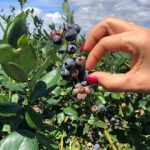
Fresh-picked blueberries are perfect in smoothies and salads.
Photo source: Alex Hinkle
Half MyPlate
The USDA (United States Department of Agriculture) recommends half of your plate be fruits and veggies. Eating in this way gives your body the nutrients it needs to get healthy and stay healthy. Vitamins, minerals, water, and fiber are packed into summer produce. Eat a variety. Try produce in every color, texture, shape, and size. To pack a tasty, healthy wallop for your next meal, make a hot multi-veggie hash alongside a cold refreshing fruit salad. For more ideas on how to add more fruits and veggies into your day, go to Liven Up Your Meals with Fruits and Veggies.
Summer’s Bounty – get it now, enjoy it now!
by Samantha Kennedy | Aug 5, 2017
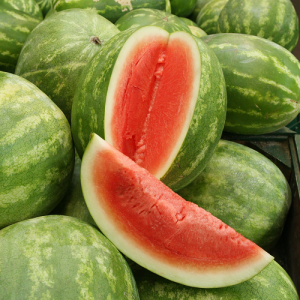 Oh, watermelon. How do I love thee? Let me count the ways.
Oh, watermelon. How do I love thee? Let me count the ways.
Watermelon is the perfect warm weather treat and a summer holiday essential. It’s a sweet, light, and delicious snack and its versatility lends itself to a wide variety of beverages, salads, meals, and desserts.
Watermelon is more than just water and sugar. It’s jam-packed with a number of vitamins and minerals that can help you stay healthy, including vitamin A, vitamin B6, vitamin C, potassium, and lycopene.
Vitamin A is vital to eye health and helps boost your immune system by supporting the functions of the infection-fighting white blood cells.
Vitamin B6 has many functions in the body, including aiding in immunity by supporting the creation of antibodies, which are needed to fight off infection. It also helps maintain proper nerve function and aids in the creation of red blood cells, which carry oxygen to all parts of the body. Vitamin B6 is also used to break down proteins into smaller parts that can be used to build and maintain muscle mass.
Vitamin C also helps boost immunity and overall cell health by helping to break down free radicals in the body, which can deteriorate cells over time.
Potassium is a mineral that is necessary for keeping a healthy water balance in the body, helping to maintain proper water balance and reducing the incidence of painful muscle cramps.
Lycopene is one of a family of vitamin precursors known as carotenoids. This substance is what helps give those bright red and pink fruits and vegetables – such as watermelon – their lovely color. Lycopene and other carotenoids function as antioxidants, which help eliminate those previously mentioned harmful free radicals. And preliminary studies have shown that lycopene may help reduce triglycerides and LDL cholesterol, which may lead to a reduction in cardiovascular disease risk.
Nearly every part of the watermelon can be eaten, from the sweet and juicy fruit to the rind, which is often pickled or used in stir frys. Even the fruit itself can be grilled and served as part of a savory dish. And watermelon is a sweet addition to many colorful summer salads.
One of my favorite watermelon recipes is a twist on a traditional favorite – Watermelon Lemonade – and is sure to be a great addition to any of your summertime picnics. Try it today!
Watermelon Lemonade
Ingredients
1/2 cup lemon juice
2 1/2 cups water
2/3 cups agave syrup*
2 cups watermelon chunks
*Other sweeteners may be used instead of agave syrup. However, be careful when adding them, as you may need to use less. Add to taste, mixing in a little at a time until you reach the desired sweetness.
Instructions
Place all the ingredients in a blender and blend until smooth. Serve over ice.
Servings
Makes about 5 cups.
Nutrition Facts
Serving size: 1 cup
Calories per serving: 163
Fat per serving: 0.3g
Saturated fat per serving: 0.0g
Fiber per serving: 0.3g
For more delicious recipes, please visit http://www.watermelon.org/Recipes.
by Samantha Kennedy | May 27, 2017
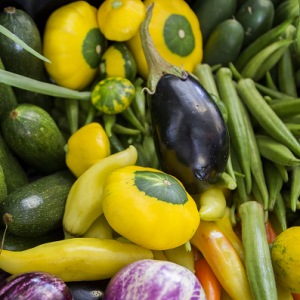 North Florida’s beautiful spring weather means we get to enjoy a variety of delicious, locally-grown fruits and veggies during the summer months. Produce such as bell peppers, squash, tomatoes, greens, corn, cucumbers, okra, peas, eggplant, and a variety of melons are plentiful and fresh from late spring through early fall.
North Florida’s beautiful spring weather means we get to enjoy a variety of delicious, locally-grown fruits and veggies during the summer months. Produce such as bell peppers, squash, tomatoes, greens, corn, cucumbers, okra, peas, eggplant, and a variety of melons are plentiful and fresh from late spring through early fall.
The benefits of eating fresh fruits and vegetables are numerous and well-known. Fruits and veggies provide important vitamins and minerals that are vital to keeping your body working properly. They’re rich in fiber, which is important for digestive health and helps lower cholesterol. They provide antioxidants, which can help reduce your risk of a variety of cancers. They’re low in calories, fat, and sodium, which make them an ideal snack. And their colorful spectrum makes them a beautiful and healthy addition to any meal.
The MyPlate https://www.choosemyplate.gov/MyPlate guidelines call for making half your plate fruits and vegetables as part of a balanced meal. But remember, preparation is key. Steamed, roasted, raw, baked, and grilled veggies will provide the biggest nutritional bang for your buck, allowing the natural flavors to shine through. Deep fried, breaded veggies add unnecessary fat and calories, so be careful not to rely on this cooking method too often.
Mix and match! Pair a leafy green with a starchy vegetable for a wider spectrum of nutrients. Add fruits such as mandarin oranges or dried cranberries to a salad for a little extra sweetness. Try new flavor combinations by adding herbs and spices – but go easy on the salt!
While fresh fruits and vegetables are healthy, delicious, and plentiful during Florida’s summer months, frozen and canned varieties, including juices, can also provide many of the same health benefits. However, be sure to read the label carefully before buying. Look for low sodium or no salt varieties and only purchase 100% juice beverages, as other drinks may contain a lot of artificial flavorings and colors.
For more information about the benefits and uses of fresh North Florida produce, please visit the Panhandle Produce Pointers page at: http://wfrec.ifas.ufl.edu/panhandle-produce-pointers/produce-pointers-sheets/.









